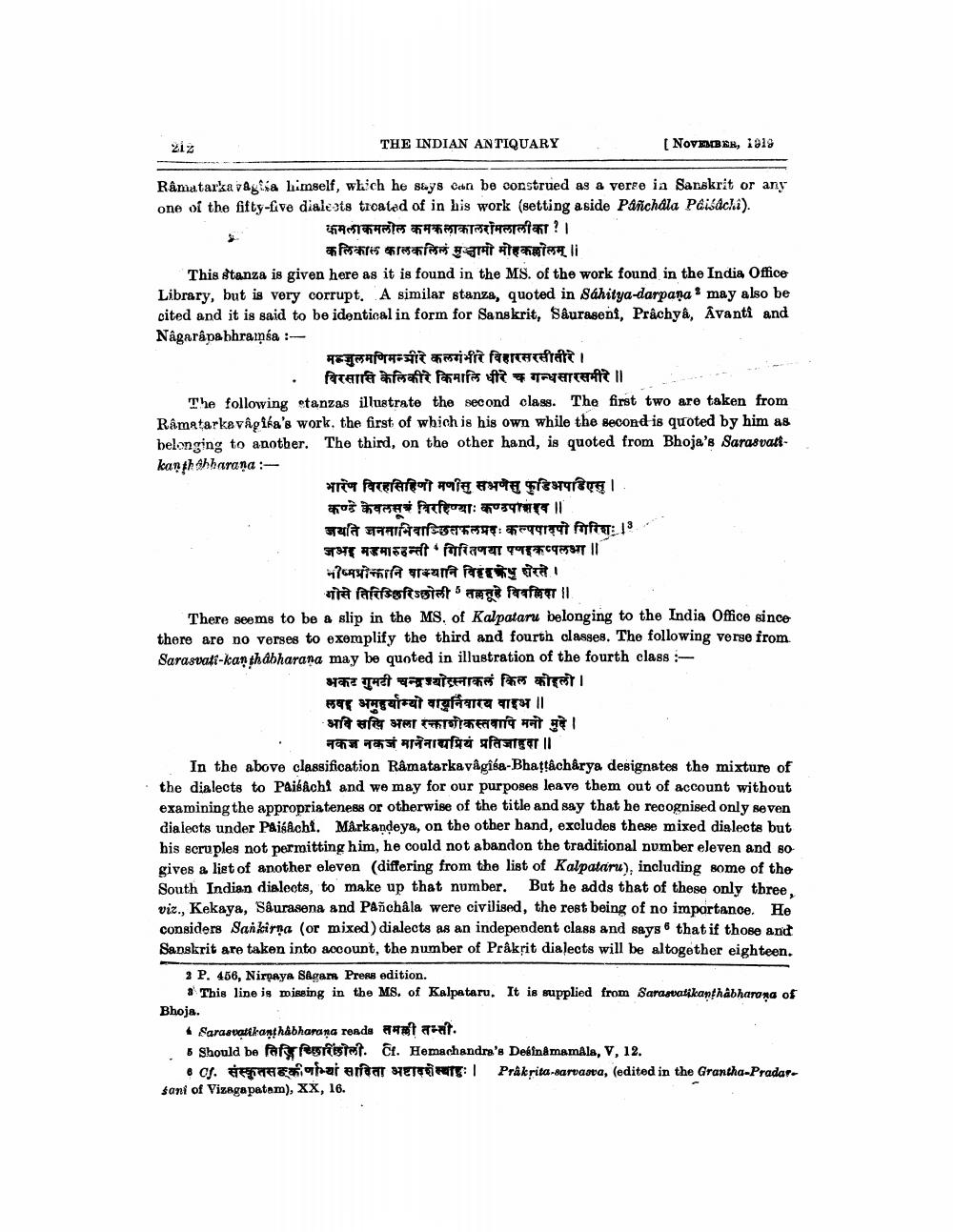________________
ziz
THE INDIAN ANTIQUARY
[NOVEMBER, ias
Râmatarka vaga himself, which he says can be construed as a verge in Sanskrit or any one of the fifty-five dialeats troated of in his work (setting aside Pañchala Paisacha).
कमलाकमलोल कमकलाकालमिलालीका!।
कलिकाल कालकलिलं मुञ्चामो मोहकलोलम् ।। This stanza is given here as it is found in the MS. of the work found in the India Office Library, but is very corrupt. A similar stanza, quoted in Sahitya-darpaņa may also be cited and it is said to be identical in form for Sanskrit, Sauraseni, Prachya, Avanti and Nagarapabhramsa:
मन्जुलमणिमन्त्रीरे कलगंभीरे विहारसरसीतीरे।
. विरसासि केलिकीरे किमालि धीरे च गन्धसारसमीरे॥ ...... The following etanzas illustrate the second class. The first two are taken from RâmatarkavÂg ika's work, the first of which is his own while the second is quoted by him as belonging to another. The third, on the other hand, is quoted from Bhoja's Sarasvatikanthahharana :
भारेण विरहसिहिणो मणीसु सभणेसु फुडिअपडिएस् । कण्ठे केवलस विरहिण्याः कण्ठपासइव ।। जयति जनसाभिवामिछलफलमक्षः कल्पपादपी गिरिशः ।। जह मडमारुहन्ती गिरितणया पणहकप्पला॥ भीष्मप्रोक्तानि पाक्यानि विहाधु शेरते ।
गोसे तिरिमिहरि छोली ' तल्लतूहे विवलिया ।। There seems to be a slip in the MS, of Kalpataru belonging to the India Office since there are no verses to exemplify the third and fourth classes. The following verge from Sarasvati kan thabharana may be quoted in illustration of the fourth class -
भकट गुमटी चन्द्रज्योत्स्नाकलं किल कोहली। लवह अमुहुर्याम्यो वायुर्निवारय वाइभ । अवि सखि अला रक्ताशोकस्तवापि मनो मुदे ।
नकज नकजं मानेनाद्यप्रियं प्रतिजाहुदा ।। In the above classification Råmatarka vågisa-Bhattacharya designates the mixture of the dialects to Paibachi and we may for our purposes leave them out of account without examining the appropriateness or otherwise of the title and say that he recognised only seven dialects under PaikAchi. Markandeya, on the other hand, excludes these mixed dialects but his scruples not permitting him, he could not abandon the traditional number eleven and so gives a list of another eleven (differing from the list of Kalpataru), including some of the South Indian dialects, to make up that number. But he adds that of these only three viz., Kekaya, Saurasena and Panchala were civilised, the rest being of no importance. He considers Sankirna (or mixed) dialects as an independent class and says that if those and Sanskrit are taken into account, the number of Prakṣit dialects will be altogether eighteen.
3 P. 456, Nirpaya Sagara Prens edition.
* This line is missing in the MS. of Kalpataru. It is supplied from Sarawatikanthabharana of Bhoja.
Saraswatikanthabharana renda तमली तम्सी . Should be afraistet. Cf. Hemachandra's Dekinamamala. V, 12. .. संस्कृतसङ्कीर्णाभ्यां सादिता अष्टादशेस्याहुः। Prakrita-sarvaava, ledited in the Grantha-Pradarsani of Vizagapatam), XX, 16.




